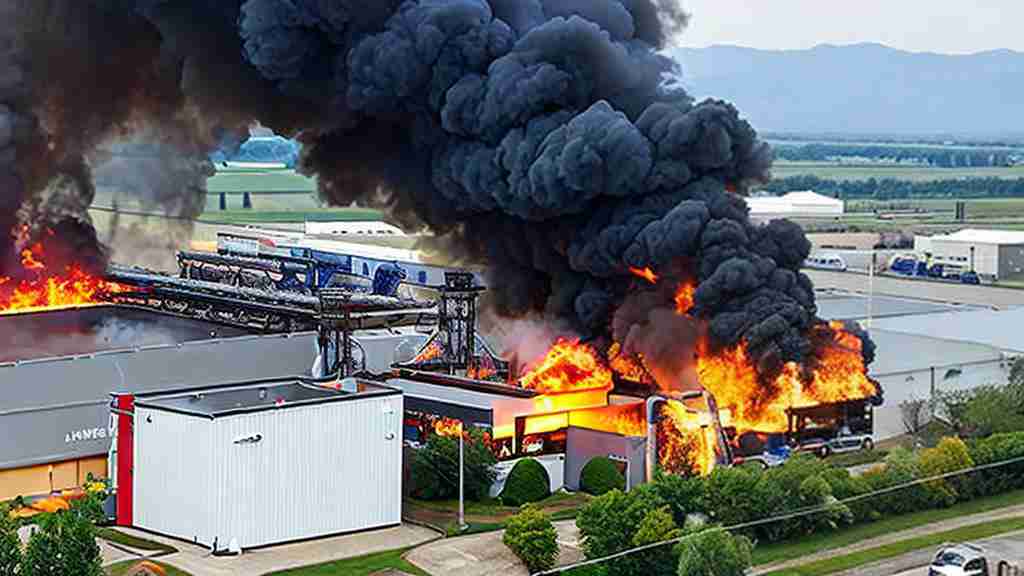Due to the presence of flammable materials, electrical equipment, and high-temperature processes, food processing plant fires play a crucial role in protecting our food quality and safety. In order to safeguard the workers, prevent property damage, and maintain the integrity of the food products. It is essential to implement effective fire prevention measures. This article provides an overview of the best practices & strategies for preventing fires in food processing plants.
Introduction
Food processing plants fires are complex environments that involve various operations such as cooking, baking, frying, and packaging. These activities often require the use of high temperatures and flammable substances, creating an environment where fires can easily ignite. Implementing comprehensive fire prevention measures is crucial to protect the employees, assets, and reputation of food processing facilities.
1. Understanding the Risks
Before developing effective fire prevention strategies, it is essential to understand the potential risks in food processing plants. Some common fire hazards include faulty electrical wiring, overheating cooking equipment, improper storage of combustible materials, inadequate ventilation systems, and insufficient fire safety training for employees. A good way to mitigate these risks is to identify them as early as possible.
2. Implementing Fire Safety Measures
2.1 Design and Layout
The design and layout of a food processing plant fires can significantly impact fire safety. Fires can spread rapidly if the appropriate spacing is not maintained between machines, storage areas, and workstations. Additionally, installing fire-resistant walls, ceilings, and floors can contain the fire within a limited area, minimizing the potential damage.
2.2 Fire Detection Systems
Early detection of fires is critical for minimizing the damage and ensuring a timely response. Installing a robust fire detection system, including smoke detectors, heat sensors, and flame detectors, can provide early warnings and activate the necessary fire suppression systems.
2.3 Fire Suppression Systems
Food processing plants should be equipped with reliable fire suppression systems to suppress fires quickly and effectively. Automatic sprinkler systems, fire extinguishers, and fire blankets are examples of commonly used fire suppression equipment. These systems should be regularly inspected, tested, and maintained to ensure their proper functionality.
2.4 Employee Training and Education
Well-trained employees are the first line of defense against fires. Conducting regular fire safety training sessions and drills can educate the staff on fire prevention, evacuation procedures, and the proper use of fire extinguishing equipment. A fire exit, evacuation route, and assembly point should be familiar to all employees.
2.5 Housekeeping and Maintenance
Maintaining a clean and clutter-free environment is crucial for fire prevention. Regular housekeeping practices should be implemented to remove flammable waste, such as packaging materials, dust, and debris. Additionally, regular maintenance of machinery, electrical systems, and ventilation systems can help identify potential fire hazards and prevent their occurrence.
3. Compliance with Codes & Regulations
Food processing plant fires must adhere to specific fire safety codes and regulations established by local authorities and industry organizations. It is essential to stay up-to-date with the latest codes and standards and ensure compliance through regular inspections and audits. Engaging with fire safety professionals can provide valuable insights and guidance on meeting these requirements.
4. Conducting Regular Inspections & Audits
Regular inspections and audits are essential to identify fire hazards and potential areas of improvement. These inspections should encompass electrical systems, heating systems, cooking equipment, storage areas, ventilation systems, and fire suppression systems. Any identified deficiencies should be promptly addressed and resolved.
5. Developing an Emergency Response Plan
Having a well-defined emergency response plan is critical for mitigating the impact of a fire incident. Employees should be familiar with the emergency response procedures through regular drills and simulations to ensure that they are familiar with evacuation procedures, communication protocols, roles, and responsibilities.
6. Engaging fire safety professionals
Engaging with fire safety professionals, such as fire engineers and consultants, can provide invaluable expertise in identifying potential fire hazards and designing effective prevention strategies. These professionals can assess the facility, review existing fire safety measures, and make recommendations to enhance fire prevention and response capabilities.
7. Ensuring Electrical Safety
Electrical malfunctions are a significant cause of fires in food processing plants. Regular inspections, maintenance, and testing of electrical systems are essential for identifying and rectifying any issues. Implementing ground fault circuit interrupters (GFCIs), surge protectors, and other protective devices can help mitigate electrical fire risks.
8. Managing Combustible Materials
Proper storage and handling of combustible materials are vital to prevent fires. Flammable liquids, chemicals, and packaging materials should be stored in designated areas with appropriate ventilation and fire-resistant containers. Implementing effective waste management practices and controlling the accumulation of combustible waste can further reduce the risk of fire incidents.
9. Safe Handling of Cooking Equipment
Cooking equipment, such as ovens, grills, and fryers, pose a significant fire hazard. Regular maintenance and cleaning of this equipment are crucial to prevent grease buildup, which can ignite and cause a fire.The use of fire suppression equipment and temperature control should be shown to employees as a part of training in safe operating procedures.
10. Preventing Chemical Fires
Food processing plant fires often use various chemicals for cleaning, sanitization, and food preservation. It is essential to handle and store these chemicals properly to prevent chemical fires. Following manufacturers’ instructions, using appropriate storage containers, and ensuring proper ventilation are key measures for chemical fire prevention.
11. Maintenance of Heating Systems
Heating systems, such as boilers and furnaces, require regular maintenance and inspection to prevent potential fire hazards. Scheduling routine maintenance checks, cleaning heat exchangers, and ensuring proper ventilation can help minimize the risk of fire incidents related to heating systems.
12. Importance of Regular Equipment Inspections
All equipment used in food processing plants should undergo regular inspections to identify any potential fire hazards. This includes checking for frayed electrical cords, damaged heating elements, malfunctioning sensors, and other equipment-related risks. Prompt repair or replacement of faulty equipment is crucial to maintain a safe working environment.
13. Case Studies: Successful Fire Prevention Strategies
In this section, we will explore real-life case studies of food processing plants that have implemented effective fire prevention strategies. These case studies will highlight the specific measures taken, the challenges faced, and the positive outcomes achieved in terms of fire prevention and employee safety.
Conclusion
Preventing food processing plant fires requires a comprehensive approach that includes robust design, proper fire detection and suppression systems, employee training, regular inspections, and adherence to codes and regulations. By implementing these best practices and strategies, food processing plants can significantly reduce the risk of fire incidents, protect their workers and assets, and ensure the integrity of the food products they produce.
FAQs
Q. Are fire prevention measures costly to implement?
Fire prevention measures may require an initial investment, but the cost of not implementing them can be much higher. Fires can result in significant property damage, business interruption, and potential harm to employees.Protecting your family and your property from fire requires a proactive approach.
Q. How often should fire safety training be conducted for employees?
An annual fire safety training program is ideal, but regular training should be conducted at regular intervals.However, additional training sessions should be scheduled whenever there are significant changes in the facility layout, processes, or equipment that may impact fire safety.
Q. Can fire suppression systems cause damage to food products?
Modern fire suppression systems are design to minimize damage to food products while effectively extinguishing fires. However, it is crucial to select the appropriate suppression system based on the specific requirements of the facility and consult with fire safety professionals to ensure compatibility with food processing operations.
Q. How can insurance companies prevent fires?
Insurance companies often provide guidance and resources for fire prevention to reduce the risk of fire incidents and subsequent claims. Working closely with insurance providers can help identify potential vulnerabilities and implement appropriate fire prevention measures.

